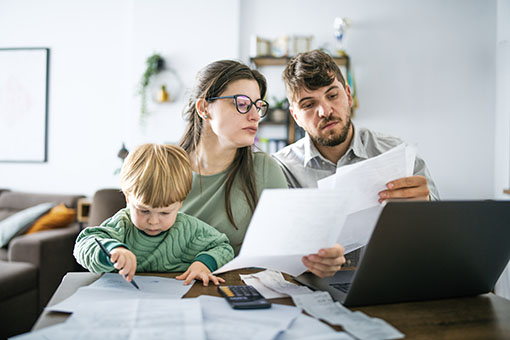How to pay off credit card debt
While there’s no one “perfect” way to pay off credit card debt, common strategies like the snowball method, the avalanche method, debt consolidation and performing a balance transfer can help you stay on top of and, ultimately, eliminate credit card debt.

If you’re looking to tackle your credit card debt, you should know that there are several paths available to you. However, finding the best strategy for your specific situation means striking a balance between your short- and long-term financial goals.
Regardless of which strategy you choose, the key is to stay consistent so you can continue to reduce your credit card debt over time.
Choose a debt payment strategy that works for you
The first step to tackling credit card debt is developing a game plan that works for your specific financial situation. But with a quick online search turning up hundreds of strategies and tactics for paying down credit card debt, how do you know which to choose?
It all comes down to one core idea: balance. After all, the best kind of debt strategy is the one that works for your life.
Your debt payment strategy should work to reduce your debt while limiting the impact on your way of life. For example, your strategy could focus on lowering your monthly payment, leaving you with more money for daily expenses. Or you could budget more toward your debts each month with the goal of paying everything off as quickly as possible.
No matter your specific goals, there are several strategies which have proven effective for helping individuals pay off their debts:
- Paying more than the minimum: All credit cards come with a minimum monthly payment that you’ll need to pay every month. The first and most effective way to pay down any existing credit card debt is to pay more than the minimum monthly payment because any balance incurs interest. Paying a higher amount monthly means paying down your principal faster. This can result in less interest over the course of the loan and a faster repayment timeline overall.
- Snowball method: This strategy focuses on paying down small debts first and then building momentum to tackle larger debts. Over time, the snowball method lowers your minimum monthly payments by focusing your resources upfront on the smallest debts that are easiest to pay off. Then, once you finish paying off these debts, you can use your newly freed-up dollars to pay down the larger debts faster.
- High-interest paydown (“avalanche method”): All debts have different interest rates. With this strategy, you focus on paying down the debts with the highest interest rates first. This will save you the greatest amount of money in the long run by lowering how much you’ll pay over the life of the loans. However, it can be hard to build and keep momentum if your debts with the highest interest rates are also the ones with the most money due.
- Consolidating with a personal loan: If you’re struggling with paying off several cards with high interest rates, or if you just want to shop for a lower rate, you may want to consider debt consolidation. Consolidating your debts means bundling them under one account. While you’ll still owe the same amount, this strategy can make the day-to-day management of your finances easier by focusing all your efforts on a single, more manageable loan that often has a lower interest rate and longer repayment schedule.
No matter which strategy you choose, the important thing is to stick with it for the long haul. Paying down your credit card debt is a marathon, not a sprint, so it’s important to choose a strategy that will work for your financial situation for as long as it takes to eliminate your debt.
Finding the right balance between your short-term goals and your long-term financial health is not something you need to tackle on your own. You can meet with your local banker.
Consider debt consolidation
If you have strong credit but are struggling to make the monthly payments on your credit cards, it may be worth your time to review the various personal loans and lines of credit available from your local bank.
As covered above, one common approach is to use a personal loan or line of credit to pay off any outstanding debt, leaving you with a single balance that will have a lower interest rate than what you would pay on credit cards.
A key aspect of this strategy is that you may opt to get rid of the credit cards entirely, making it easier for you to resist spending more money on the cards and potentially gaining new debt in a time when your focus should be on lowering your outstanding balance.
Benefits of paying off debt with a home equity line of credit (HELOC)
A specific strategy often used by homeowners is tapping into their home’s equity with a HELOC to pay down the debt.
This method centers on paying off the credit card debt with the HELOC, leaving you with the same outstanding balance but a lower monthly payment and interest rate.
A HELOC lets you borrow against the equity you have in your home. This means individuals who may not qualify outright for a personal loan can leverage their home’s equity to pay off high-interest debt, such as a credit card balance.
Let’s say your house is valued at $400,000 and you have an outstanding mortgage of $150,000. This would mean you have $250,000 worth of equity in your home. With a home equity line of credit, you could borrow against this equity (generally up to 85% of the total amount) to pay off your credit card debt, leaving you with a more manageable loan at a lower interest rate.
Plus, the increased borrowing capacity means you can consolidate other debt into your HELOC. For instance, you could consolidate any loans, medical bills or other balances that have higher interest rates (or larger monthly payments) than you could expect from your HELOC.
Consider other debt relief options
If the amount you owe is more than the amount you can pay each month, it can put a major burden on your finances and way of life. If that is the case, it may be wise to consider a few debt relief options.
For example, if your interest rates are too high, it may be worth exploring debt consolidation or taking out a personal loan or HELOC to refinance the debt and lower your monthly payments. With more specific types of debt—such as medical debt or student loan debt—you could research loan forgiveness or other programs that can help you write off portions (or even the entirety) of the amount.
See if you qualify for a balance transfer card
Balance transfers offer the opportunity for a 0% APR sign-on bonus—typically for between six months and two years—allowing you to pay down a significant amount of the principal during this period.
Since all your payments will go directly against the amount you owe, you’ll make faster progress than if you also had to pay down the interest.
Note, however, that most balance transfer cards require a relatively high credit score and many will charge a balance transfer fee equal to around 3 to 5% of the amount being transferred.
Take advantage of resources at your local branch
Credit card debt is a common problem that many people face every day—and there are options available for helping you quickly pay it down.
From basic strategies such as paying more than your monthly minimums to more targeted strategies such as the snowball or avalanche methods, common approaches often center on paying down the principal as quickly as possible to minimize interest payments over time.
If you’re having trouble making your minimum payments or these methods don’t work for you, know that you still have options. Consider looking at alternative approaches such as debt consolidation or performing a balance transfer to a 0% APR card.
Need help getting started? Schedule an appointment to meet with a dedicated expert in financial wellness at an Associated Bank near you. Together you can choose a strategy that works for you to tackle your credit card debt. You’ve got this. We’ve got you.





